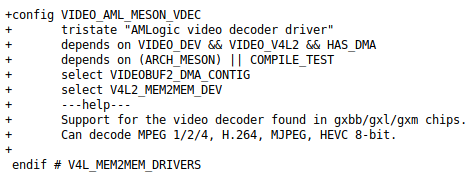Allwinner processors aren’t the only ones getting an open source hardware video decoding / encoding support in Linux, as Maxim Jourdan recently submitted a patchset to Amlogic Linux mailing list adding a video decoder driver to some Amlogic processors.
 The driver is written around the V4L2 M2M framework and currently supports MPEG 1/2/4, H.263, H.264, MJPEG, and (partially) HEVC 8-bit codecs. The driver has been tested with FFmpeg, GStreamer, and Kodi, and currently works on S905 (Meson GXBB), S905X/W/D (Meson GXL), and S912 (Meson GXM) processors.
The driver is written around the V4L2 M2M framework and currently supports MPEG 1/2/4, H.263, H.264, MJPEG, and (partially) HEVC 8-bit codecs. The driver has been tested with FFmpeg, GStreamer, and Kodi, and currently works on S905 (Meson GXBB), S905X/W/D (Meson GXL), and S912 (Meson GXM) processors.
Those processors also support HEVC 10-bit, VP9, and VC1 codecs, and while those are implemented yet, they should be in the future.
A separate commit adds support for “Overlay plane for video rendering” which support various YUV layouts and a non-alpha RGB32 layout, and will be useful for Kodi and LibreELEC ports.
I came to learn about those two patchsets thanks to Neil Armtrong (Bay Libre) who also mentioned he will talk about Amlogic open source video decoder and Kodi/LibreELEC ports during a session at Embedded Recipes 2018 taking place on September 24-25 in Paris, France.

Jean-Luc started CNX Software in 2010 as a part-time endeavor, before quitting his job as a software engineering manager, and starting to write daily news, and reviews full time later in 2011.
Support CNX Software! Donate via cryptocurrencies, become a Patron on Patreon, or purchase goods on Amazon or Aliexpress




